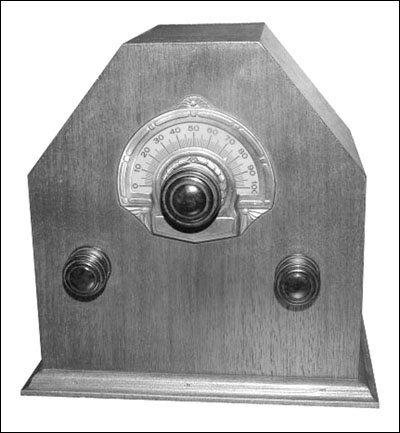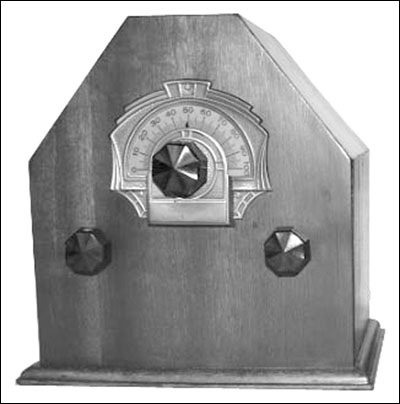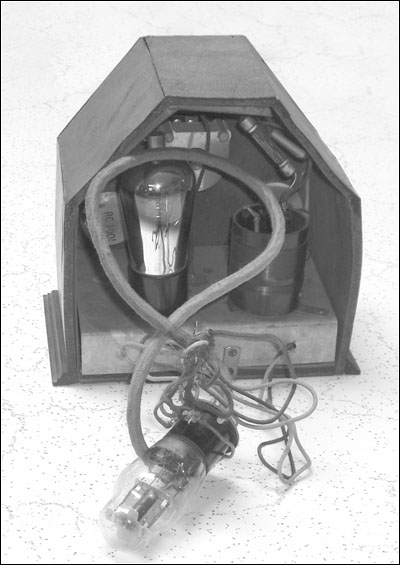Of Old Radios And Related Items--Published Monthly
The Shorty Manufacturing Company
BY ART REDMAN
WEB EDITION
Art Redman is a source of serious research on radio manufacturers of the Pacific Northwest. His previous articles in A.R.C. were "Northwestern Radio Manufacturing Company" in September 2005 and "Hallock and Watson" in June 2006. (Editor)
In the early 1930s, interest in shortwave listening increased when several radio manufacturing companies had a police band feature on wavelengths above the standard broadcast band. The nation was in the midst of the Great Depression, and a low-cost alternative to expensive shortwave radios and converters was needed. Sparton and Stewart-Warner were already manufacturing shortwave converters by 1933. This demand prompted thirty-five year old Ray Leith Reid and his brother George S. Reid to manufacture less expensive shortwave adapters. The idea of adding a low-cost, plug-in tuner box to an existing radio was a sure thing.
The Reid brothers' Shorty Manufacturing Company was located at 2730 East Burnside Street in Portland, Oregon, where the market for shortwave radios was especially strong. KGPP or "Government Portland Police," the 500-watt police radio station, was located on the southwest slope of Mt. Tabor at Water Reservoir No. 5. It was on the air at 2.442 MHz beginning in 1932. In addition, the airport radio station at Swan Island created strong local interest in shortwave, thereby creating an additional selling point for the Shorty adapters.
The Shorty Products
The Shorty Company produced two shortwave adapter models -- the Shorty and the All-Aire. These adapters, shown in Figures 1 and 2, were designed for use with broadcast-band radios that used either a triode or a screen-grid tube as a detector. Closeups of the dials for the Shorty and the All-Aire models are shown in Figures 3 and 4 (see print version).
B+ and filament voltages for the adapters are obtained from the broadcast radio by means of a cable and tube socket. Figure 5 shows the cable and the tube socket with the broadcast radio's triode detector tube plugged into the tube socket. The tube's pins extend through the inverted wafer socket, and the tube and socket are then plugged into the radio's detector socket.
Figure 1. The Shorty model shortwave adapter is distinguished by its round knobs.The schematic diagram for the Shorty model is shown in Figure 6 (see print version). It is a regenerative detector. The antenna and ground wires are connected to the broadcast radio's antenna and ground terminals. If the broadcast receiver used a triode detector, the black and red wires are connected. If a screen-grid detector is used, then the black and green are connected. The adapter could also be used with receivers having 6.3-volt tube filaments. The company recommended a good 35-foot outside aerial and a good ground.
What was unique about the Shorty adapters was that the radio's detector tube remained in place and was not removed and replaced by a socket plug. The wafer connected the adapter to the B+ supply and filament voltages of the broadcast band radio. Also the antenna and ground wires were connected to the radio receiver, unlike other adapters of the 1930s which had separate antenna and ground posts.
Figure 2. The All-Aire model shortwave adapter uses the same cabinet style as the Shorty, but has a different escutcheon and hexagonal-shaped knobs.The Shorty Company models
The Shorty model adapters were housed in tombstone style wood cabinets. The company interchanged model names so a collector could find an adapter with a Type 36 or a Type 24A screen-grid tube, or a Type 37 triode, depending on which label was placed on the bottom. Cabinet labels are shown in Figures 7 and 8 (see print version).
The Shorty model with the Type 37 triode tube measured 65/16" high x 67/16" long x 45/8" wide. The label on the underside had a space to write in both the police and airport frequencies. This model had a 72-ohm RF choke in the plate circuit and two controls -- a variable 0.00016 mfd, 7-plate tuning capacitor, which controlled regeneration, and a 2-plate trimmer capacitor.
The All-Aire model used only a Type 24A or 36 screen- grid tube. It measured 7" high x 71/4" long x 45/8" wide and had a "patent pending" stamp. It weighed two pounds, and had an additional variable 92K resistor controlling screen grid voltage and thereby volume. The 2.5-megohm grid leak resistor was made by the International Resistance Company. The 0.00025 mfd grid leak bypass capacitor mounted under a 40-gauge galvanized sheet metal chassis was made by the Girald Hopkins Company of San Francisco.
Shorty Adapters in Use
Mike Parker, an owner of the All-Aire adapter with a Type 24A screen-grid tube, reports that it works well with his Atwater Kent Model 40 receiver. The reason for this is that his receiver has a Type 27 triode tube detector, which is not always the case with other receivers.
Poor shortwave reception often resulted from using an improper receiver. Using the plate voltage of standard broadcast receivers often leads to over 180 volts being applied to the plates of the detector tube or voltages too low in the case of resistance coupled amplifiers. Also the amplification of the broadcast radio's RF amplifier is lost and not enough audio gain is provided in receivers with only one stage of audio amplification. Alfred Ghirardi in his book Radio Physics Course went so far as to recommend a shortwave converter instead of an adapter "unless the receiver is of such design that proper voltages are provided for an adapter."
The Shorty Company adapters were intended for receiving local shortwave stations in the Portland area, such as the police and airport stations described earlier.
Figure 5. Connections between the adapter and the radio are made using the cable and wafer tube socket shown in this photo. The external tube is the detector tube from the radio.The Shorty Company 1934-1940
According to city directories, the Shorty Company was in the manufacturing business only in 1934 and 1935 with production limited to two models. By 1936, Types 27, 24A and 37 tubes were obsolete and were replaced by the octal type. It is not known whether the Reid Brothers ever tried to market their adapters beyond the Portland area and how many adapters were sold outside Oregon and Southwest Washington.
From 1936 to 1939, as the Shorty Radio and Electric Company, Ray Reid sold radios having shortwave bands, which helped to make the original adapters obsolete. In 1940, the company was no more. Today the former factory site on 2730 East Burnside Street is a barber shop.
The Reid Brothers, outside of local radio collectors, are not known for their entry into the radio manufacturing business. Ray worked as a barber and cab driver in Oregon City, Oregon, and died in 1966 at the age of 67. He was an active sports fisherman. George died in 1982 at the age of 79 and worked for the Colyear Motor Company in Salem, Oregon, for 35 years.
References:
"George S. Reid," Obituary, The Oregonian, November 15, 1982, p. D8.
Ghirardi, Alfred A. Radio Physics. Radio and Technical Publishing, Company, 1933, pp. 826 -827.
Hauser, Tony, Member Northwest Vintage Radio Society and owner of a Shorty having a Type 37 tube.
Johnston, Jay, Member Northwest Vintage Radio Society, owner and provider of photos and a Shorty model schematic with a Type 36 tube and an All-Aire model with a Type 37 tube.
Parker, Michael, Member Northwest Vintage Radio Society and owner of an All-Aire model shortwave adapter with a 24A.
"Ray Leith Reid," Obituary, The Oregonian, November 19, 1966, Section 3, p. 6.
"Short Wave Sets Boom," The Oregonian, December 4, 1932, Section 1, p. 17.
(Art Redman, 7731 SE 44th Avenue, Portland, Oregon 97206)
Art Redman is a charter member of the Northwest Vintage Radio Society, which was founded in 1974. He is a frequent contributor to the Society's newsletter "The Call Letter." His current interest is in research of Pacific Northwest manufacturers.
| [Free Sample] [Books, etc., For Sale] [Subscribe to A.R.C./Renew] [Classified Ads] [Auction Prices] [Event Calendar] [Links] [Home] [Issue Archives] [Book Reviews] [Subscription Information] [A.R.C. FAQ] URL = http://www.antiqueradio.com/Mar07_Shorty_Redman.html Copyright © 1996-2007 by John V. Terrey - For personal use only. Last revised: February 28, 2007. For Customer Assistance please contact ARC@antiqueradio.com or call (866) 371-0512 toll free
Antique Radio Classified |


